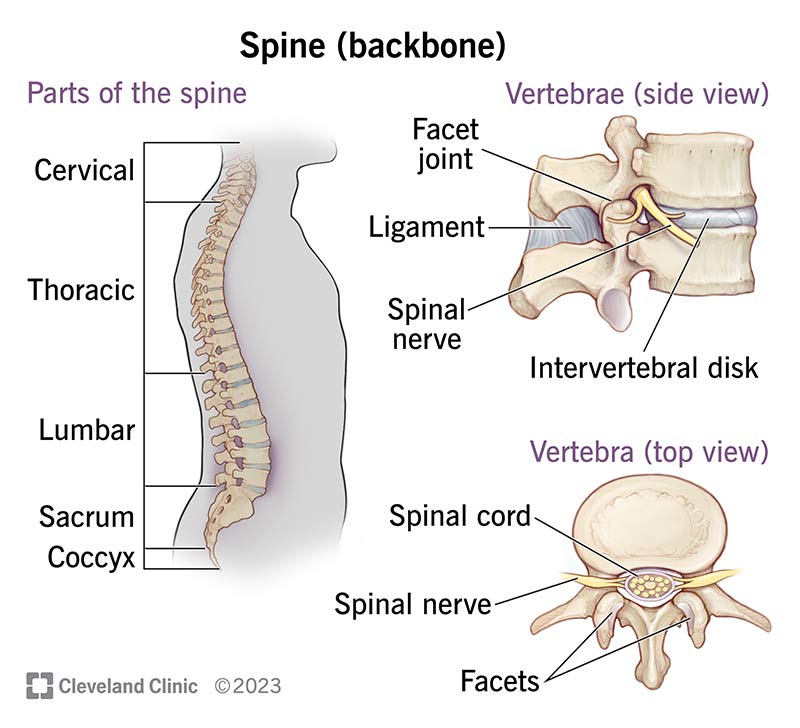Your spine is an important bone structure that supports your body and helps you walk, twist and move. Your spine is made up of vertebrae (bones), disks, joints, soft tissues, nerves and your spinal cord. Exercises can strengthen the core muscles that support your spine and prevent back injuries and pain.
Advertisement
Cleveland Clinic is a non-profit academic medical center. Advertising on our site helps support our mission. We do not endorse non-Cleveland Clinic products or services. Policy

The spine, or backbone, is a bony structure that supports your body. It connects different parts of your musculoskeletal system, which includes your body’s bones and muscles. Your spine helps you sit, stand, walk, twist and bend.
Advertisement
Cleveland Clinic is a non-profit academic medical center. Advertising on our site helps support our mission. We do not endorse non-Cleveland Clinic products or services. Policy
Your spine has several important functions, including:
Your spine is the long column of bones that extend from your neck to your lower back. Your spine starts at the base of your skull (head bone) and ends at your tailbone, a part of your pelvis (the large bony structure between your abdomen and legs).
A healthy spine has three natural curves that make an S-shape. These curves work as shock absorbers to protect your spine from injury.
Several bones and soft tissues make up your spine. They connect like bricks, stacked one on top of the other and help support your body in different ways.
Advertisement
Thirty-three vertebrae make up five distinct spine segments. Starting at your neck and going down toward your tailbone, the segments of your spine include:
Your spine plays an important role in your daily life. It gets a lot of wear and tear, putting it at risk for damage and injuries. Common conditions that affect spine health include:
Other spine conditions include:
The most common symptom of spine conditions is back pain or neck pain. Up to 80% of Americans experience back pain at some point in their life.
Other signs and symptoms of spine conditions include:
A healthcare provider may use the following tests to check the health of your spine:
Advertisement
Treatment for each spine condition varies based on the type. Common treatments for spine conditions may include:
Strong back muscles can protect your spine and prevent spine conditions. Try to do back-strengthening and stretching exercises at least twice a week. Exercises like planks strengthen your core (abdominal, side and back muscles) to give your spine more support.
Other protective measures include:
Talk to a healthcare provider about how you can keep your spine and other bones healthy.
You should call your healthcare provider if you experience:
Your spine is a complex structure of small bones, cushioning disks, nerves, joints, ligaments and muscles. This part of your anatomy is at risk of injury, arthritis, herniated disks, pinched nerves and other conditions. Back pain can affect your ability to complete your daily routine or participate in activities you enjoy. Your healthcare provider can help ease back pain and offer suggestions to strengthen the muscles that support your spine to prevent injuries.
Advertisement
From sudden injuries to chronic conditions, Cleveland Clinic’s orthopaedic providers can guide you through testing, treatment and beyond.

Last reviewed on 10/18/2023.
Learn more about the Health Library and our editorial process.